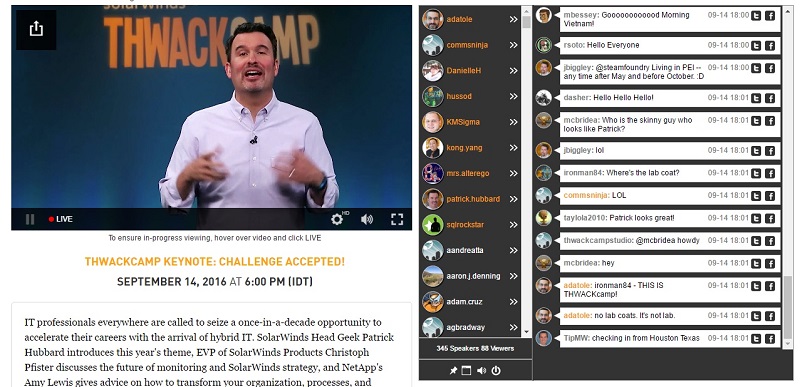We had the pleasure of working with SolarWinds on their fifth annual THWACKcamp event, which featured 7000 chatters in 20 rooms.
SolarWinds senior product manager, Rachel Morrill, shared with us some valuable information about THWACKcamp. Thank you, Rachel!
Could you describe what THWACKcamp is all about?
THWACKcamp is SolarWinds’ free, annual, virtual IT event that provides IT pros around the world with intermediate to advanced educational content.
It also allows like-minded IT pros, SolarWinds technical staff, and industry experts a chance to interact with each other on topics around monitoring, reporting, troubleshooting, and performance management.
How was the event handled?
The live event was hosted on SolarWinds online community THWACK, which has over 130,000 members. We started each day of the event with an open keynote session and live chat where visitors could see the active conversation and ask questions.
Following the keynote, registrants were given the option to access the rest of the day’s information via a how-to track or a thought leadership, IT industry track.
The tracks, each featuring its own live stream and respective chat, ran simultaneously. As each session was wrapping up, we provided a pop-up notification, which prompted participants to choose their next session and track.
This notification also allowed us to shut down the chat, move the user to the next session, and open the next chat rooms.

How would you describe the SolarWinds experience?
The transition from session to session and moving between tracks was incredibly smooth. By utilizing the RumbleTalk API into our platform, it was possible for us to easily turn the chats on and off to avoid lingering conversations.
Our users never experienced any hiccups or latency in their messages getting delivered, which was something we faced with our previous solution. And they had the ability to “pin” the conversation at a certain point, so they could spend time scrolling through the messages at their pace, which they raved about during the event.
This ability also came in really handy for our moderators, because when you have over 1,000 people simultaneously chatting, it is critical to be able to see the question. After the event, we received so many emails from attendees giving us rave reviews about the quality of our videos and the smoothness with which our chat functioned. It was a great improvement to past solutions.
After the event, we received so many emails from attendees giving us rave reviews about the quality of our videos and the smoothness with which our chat functioned. It was a great improvement to past solutions.
Is there anything else you would like to add?
The customer service and the responsiveness we received from RumbleTalk was incredibly reassuring after having experienced some performance issues with last year’s vendor.
When we identified an issue, Eyal and Nim were incredibly quick to resolve it, or work with us on a temporary workaround while they added our feedback or issue to their roadmap.
On the day of the event, Eyal contacted me, just to make sure we felt comfortable with everything and to let me know that they were there if anything should happen.
As the product manager who recommended and implemented the chat client, words cannot express the sense of relief I felt knowing RumbleTalk had my back every step of the way.

